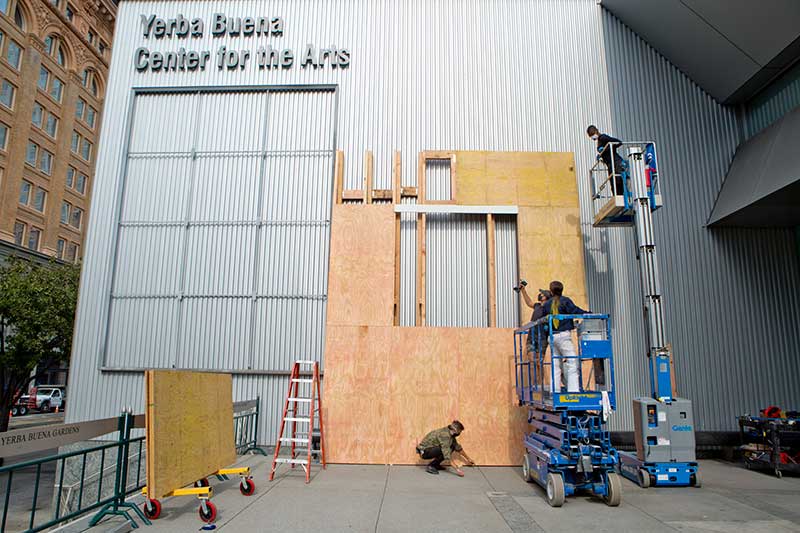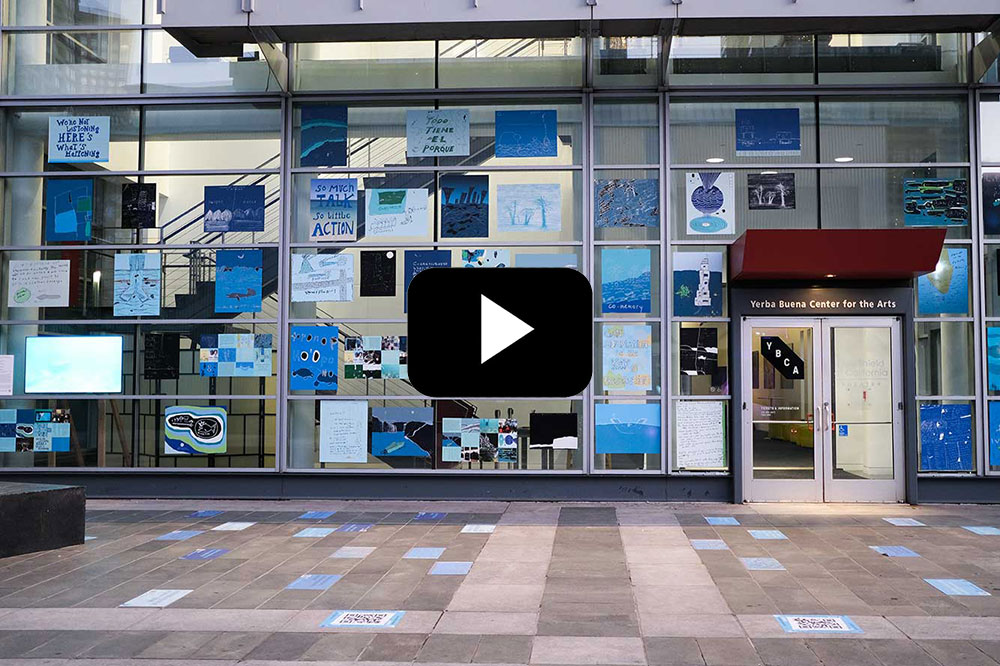Thu July 10th Open 11 AM–5 PM
We Are the Asteroid: Art and the Ecological Crisis
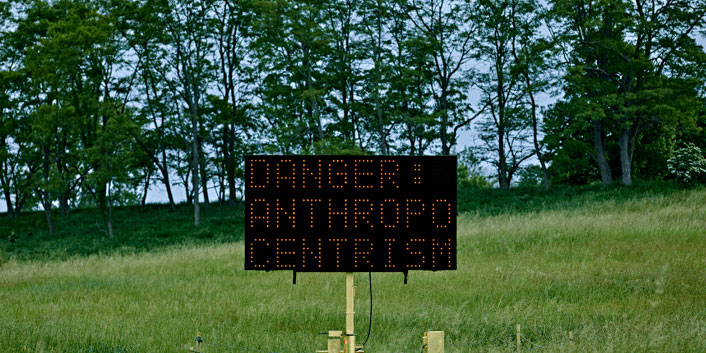
Justin Brice Guariglia is a visual and conceptual artist known for his photographic, sculptural, and installation work that explores the relationship between humans and the natural world. In honor of Earth Day, YBCA interviewed Guariglia about his text-based public art installation WE ARE THE ASTERIOD III (2019). The solar-powered LED highway message board is currently on view in YBCA’s Mission Street plaza and features Guariglia’s “eco-haikus”, created in collaboration with philosopher Timothy Morton.
How did your collaboration with philosopher Timothy Morton and the resulting work WE ARE THE ASTEROID III come about?
I first learned about Timothy Morton when an artist visiting my studio started mumbling the word “hyperobject.” He mentioned there was an eco-philosopher named Timothy Morton who wrote a book entitled Hyperobjects, and suggested I read it. I immediately bought the book and tore through it from cover to cover, thrilled that someone had put into words all of the things I was thinking and feeling, but at the time, unable to verbally express.
As the French philosopher Bruno Latour has suggested, “…the problems in understanding climate change—in the geographical, geological, social, and political senses—is one of language, of translating huge and often abstract databases and events for human comprehension.” Morton, on the other hand, talks about non-human beings, and the need to think about both human and non-human temporal and spatial scales. For me, Morton’s work started to provide a language and a conceptual framework that I needed to wrap my head around the subject.
So I decided to reach out to Professor Morton, say hi, and ask him if I could share some of my work with him that I saw as aligned with his writing. We began a dialogue. I sent him images of my works on polystyrene, which were knotty, hyperobject-y materials, and several months later I asked if he’d be willing to write some aphorisms for me that I could use in my work. Those aphorisms gave birth to our eco-haiku project entitled: WE ARE THE ASTEROID.
WE ARE THE ASTEROID III, currently on view at YBCA, is the 3rd iteration of this work. It takes the form of a solar-powered highway message board that’s been sandblasted and the steel surface oxidized, flashing a set of our “eco-haikus” that came out of our collaboration.
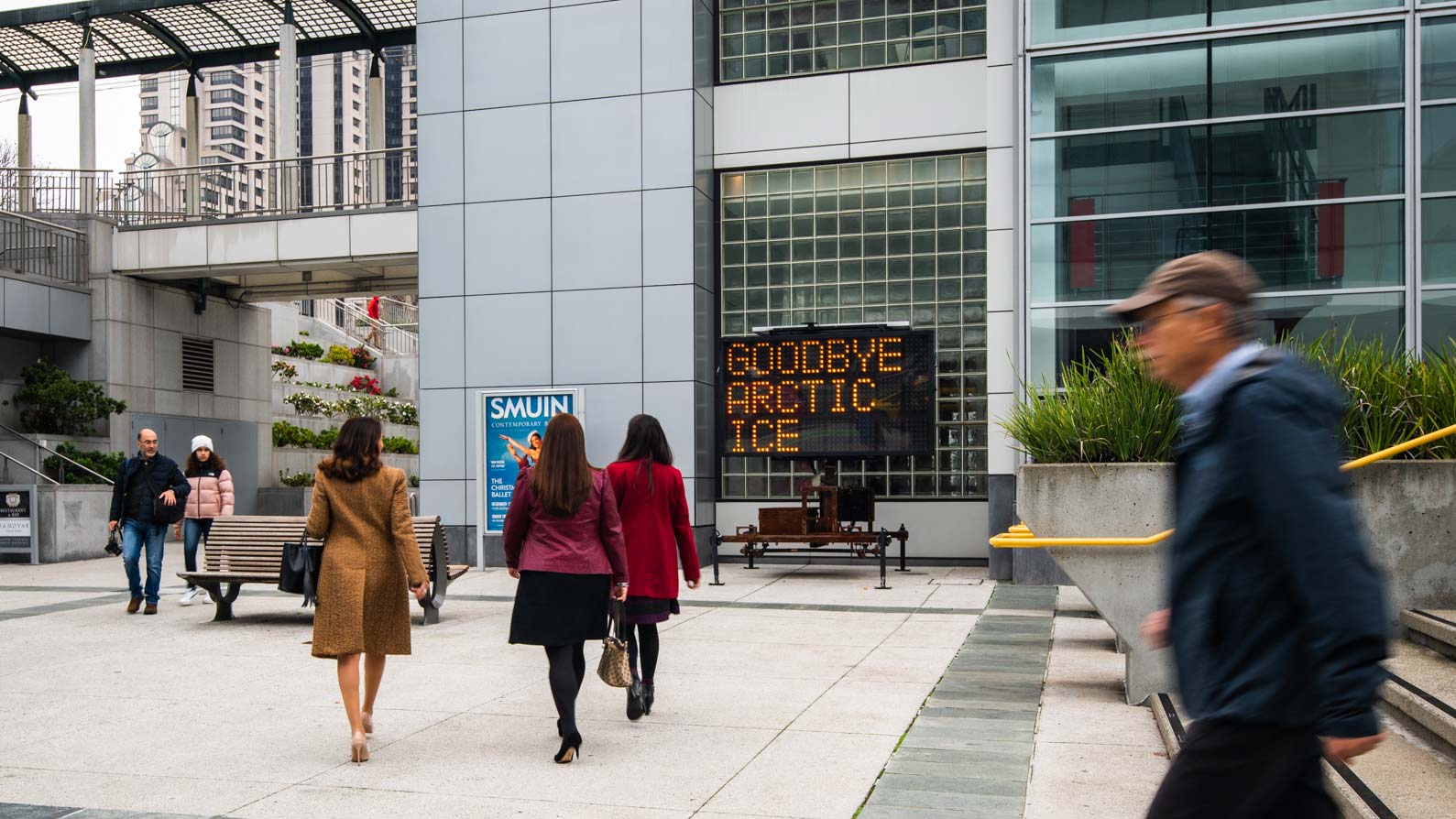
You’ve collaborated with other artists, researchers, scientists, and philosophers in your work. Why is it important to you to engage with a range of disciplines and how does this process inform your practice?
Just as we are seeing with COVID-19 today, scientists and experts are incredibly important. If you want to really understand something you need experts, not hunches. Much of my work addresses existential issues, so I believe it’s crucial for the work to be grounded scientifically in some way, shape, or form. As an artist exploring a broad, wide-ranging subject like climate change, I feel a need to converse with experts–be they climatologists for their expertise on how the climate is changing, philosophers for how to help us think about these issues, or poets who understand how to communicate ideas powerfully through words. All these individuals help me work through my thoughts by shedding unique and rather powerful light on the topics I’m trying to address.
Your work utilizes what you’ve described as “eco-haikus.” Can you explain what they are and how you worked with Timothy Morton to develop the specific language for this work?
I’ve been called out more than once over my use of the term “haiku” so maybe better we say they are “haiku-like” in that they are short 3 line sayings. With that disclaimer out of the way, the original idea was to create a series of aphorisms. I was inspired by artist Jenny Holzer’s seminal “truisms” and when I sat down to write something that was ecologically focused, I quickly recognized that wow, this was really hard! I was struggling to come up with the words that communicated what I was feeling. I’m not a writer, at least I’m not a good writer (!), not in the way I needed to be to clearly communicate the points I wanted to make and the way I wanted to make them.
I began doing some research and learned that Jenny Holzer had actually collaborated with many different writers. That inspired me to reach out to Morton to see if he’d partner with me. Having spent decades writing and teaching the “ecological thought,” I was happy that he was interested in the project.
In coming up with the aphorisms, after our initial discussion, Tim would shoot me text messages in rapid fire succession. It was very much a stream of eco-consciousness that happened in fits and starts for several weeks. I suspect he’d have a few free minutes and send me one aphorism and then another. Suddenly I had hundreds of them that I’d transcribed and it became a matter of editing a cohesive set that I felt was effective for the artwork.
WE ARE THE ASTEROID III is a public artwork that has been displayed in various cities such as Houston and San Francisco. What do you hope the impact of this work is on the general public?
I hope the work gets people to think, and ultimately, behave ecologically. The medium–a solar powered highway message board–is simply meant to grab people’s attention, to be unmissable and remarkable. Once it has your attention, most people have an automatic response to what they are seeing, and repeat the words out loud or to themselves. In that sense, it’s a rather subversive artwork. The medium performs a mini-hack on your “sensory gating” that allows the text to sneak past your brain’s noise filters. When we talk about global warming and ecological collapse, sadly we need a strong, blunt, and rather direct message that cuts through all of the noise.
As the guy who “invented the internet” says, climate change is an “inconvenient truth.” The effects of global warming are fairly easy to miss. Although we experience weather on a daily basis, we are not necessarily able to perceive changes to the climate–a shifting climate is much more subtle and nuanced. Yet, it’s happening all around us, non-stop, while we sleep, while we have our morning coffee, while reading this interview. As long as the global economy is chugging away burning fossil fuels, the planet will continue to undergo massive amounts of poorly understood and potentially catastrophic change.
As I write this, scientists have observed a new milestone of 417ppm of CO2 in our atmosphere. The last time the earth had that much CO2 in its atmosphere was around 3 million years ago, before humans were on the planet. We’ve literally entered into a geological period of time that is novel to the human species, and not even scientists can tell us exactly what the outcome will be, but rest assured it’s pretty grim.
One of the great issues of our time is the misinformation about global warming. For years average Americans have not known what to believe or what to do. The doubt around global warming and its consequences has been deeply ingrained into society by fossil fuel companies in the same way the tobacco industry stoked doubt over tobacco causing cancer in the 1980’s. Doubt or ambivalence about climate change, or the effects thereof, are the products of big industry yet again misleading the public to generate more income and protect their investments in wildly profitable systems and structures at the expense of our collective future. To paraphrase the writer Mary Annaïse Heglar, the climate crisis is not due to a lack of information, it’s a product of malice and greed.
Can you tell us more about your 2015 residency with NASA, and how that shifted your understanding of humanity’s influence on climate and the environment?
Research is at the core of my art practice, and to understand global warming, I think it’s imperative to get out into the field and see what’s happening.
In 2015, I called NASA and asked to join their Earth Science Mission called Operation Ice Bridge—the largest polar ice survey ever conducted. I had the privilege of flying 7 mission flights with them as an artist. My intention and interest was to learn as much as I could about the cryosphere from the scientists by gathering first hand knowledge of the situation and collecting a body of raw material (photos and videos) that I could take back to my studio and use to make artworks. The flights were spectacular and quickly made me very passionate about the landscape and the science. The raw footage was daunting. During the first four flights, I spent most of the 8 hour flights lying prone on my stomach on the floor of the cockpit, at the foot of the pilot, pointing my cameras out of the small drop window of their C-130 military transport plane. On the last 2 flights, I had forgotten my dramamine medication (these are very low altitude flights and the turbulence was intense), and spent a good portion of those flights turning various shades of blue and red while tucked into a ball to keep pressure on my retching stomach. It was not pretty, but lucky the crew was sympathetic.
I’d say the most important thing I experienced in the field was the clear and direct connection between the burning of fossil fuels and global warming–the visible effect of melting glaciers, our planet’s thermostat. It was an undeniable and shocking realization. More importantly, it made me realize that the warming of our planet was a moral and ethical crisis of our own making and reckoning.
How is the subject of climate personal to you? How do you relate to the natural world?
I’ve felt a strong connection to the natural world since childhood. Today, I have 2 children that live in an urban jungle and my kids, like all children on this planet, will have to manage the earth system we pass on to them. I feel responsibility. I’m also a big believer in Albert Camus’ saying, “Those of us that can speak have the responsibility to do so.” I take that as a call to arms.
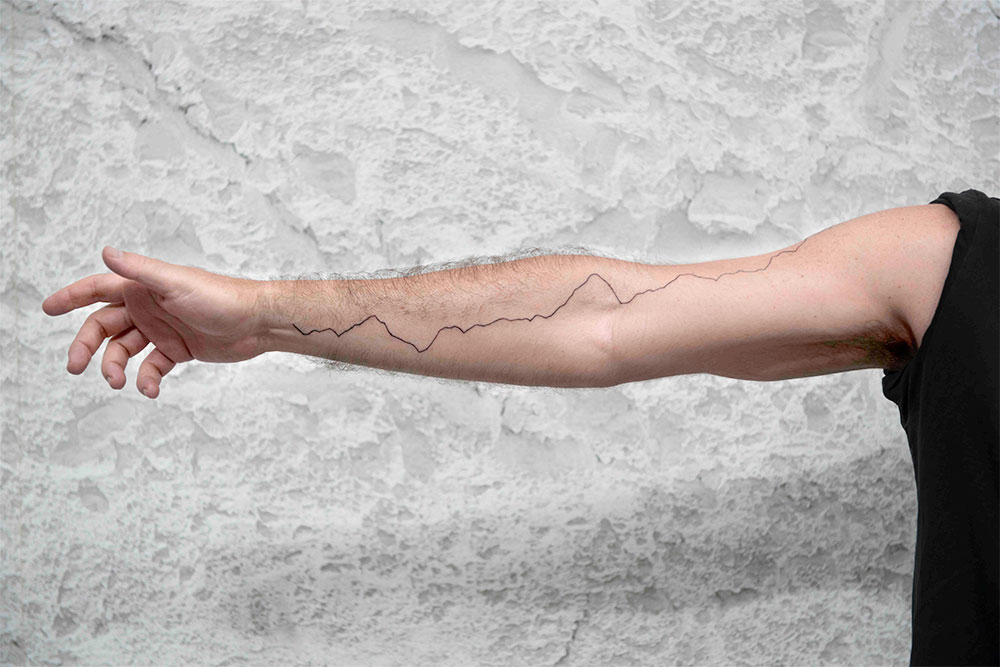
Why is it important for artists to respond to key issues facing our community and our world? Why should artists address these themes in their work?
Artists are the original cultural influencers, we have the ability to shape social discourse and a responsibility to do so. Art can and should be used as a force for political and social change.
Around the same time the hurricanes hit Puerto Rico back in 2017, the film Human Flow by Chinese artist and human rights activist Ai Weiwei debuted. I called Weiwei and said we should go down to Puerto Rico to do some research and see the impacts the storms had on the locals. I told him that the storms’ destructive powers debilitated the islands, setting off the largest mass migration of people into mainland America since the Great Potato Famine of the 1800’s (some 130,000 people eventually relocated because of the storms)… It was a massive climate-driven migration crisis. We flew down to the island and went to help my friend, the architect Walter Meyer, install solar panels and we explored the island doing our own research (NBC video). It was on that trip that Weiwei explained to me how all art is really political… that all action, or inaction, is ultimately a political choice.
COVID-19 will dissipate in months or years from now. Many will suffer, that we can be certain of, but climate change is lurking right around the corner with a bite much more vicious than this terrible virus. Moreover, those that have contributed the least to the problem, the poorest of the poor, will suffer the greatest–as we are seeing with countries like Bangladesh, Syria, and Guatemala which are being deeply impacted by changing climates and rising seas.
I’m afraid to say if we don’t get our act together, COVID-19 will merely be a dress rehearsal for a series of global climactic impacts that will pack a much greater punch.
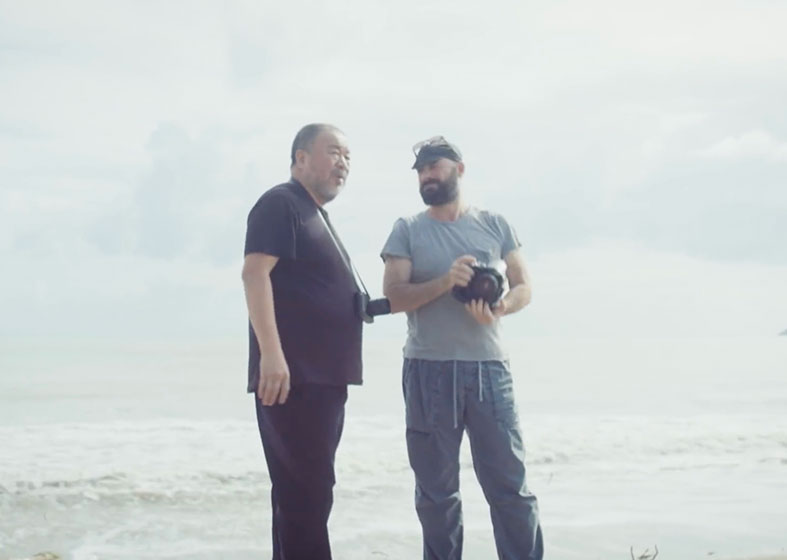
What can an individual do to fight climate change?
The reality is climate change is not solvable on an individual or personal level, it requires a globally coordinated systemic fight.
I want to mention personal shaming which has become a popular topic in the last year or so. I think few realize that the shaming of personal choices has become another misdirection, another way to divert our attention from the real problem that is the fossil fuel industry.
It’s wrong to feel shame for booking flights or driving your car. Airlines in America for instance, contribute only 3% of America’s CO2 emissions, and 2.5% of the world’s emissions. Yes, we must drive emissions down below zero, we must push not to be carbon neutral but carbon negative… but that will never happen on the scale it needs to happen by shaming consumers to make personal choices to fly less, or drive less, or recycle more. These are often good intentions by good people, but they are red herrings that actually mislead us into thinking we’re doing our part and helping to save the planet. ‘Personal choices’ are the equivalent of jumping up and down and shouting at the TV while watching your favorite sports team; you will have no effect on the final score of this game. Studies have shown that just 100 companies on the planet are responsible for 71% of global emissions. The real game changers are governments which we urgently need to write laws and mandate change to hold corporations and industry responsible for their impacts. We need political change and institutional change.
So what can we do? The most basic thing that needs to happen is something that we humans do really well– we need to talk about these inconvenient truths with family and friends. We can also demand that corporations we shop from or work for adopt environmental initiatives to reduce their carbon footprint. We can march and protest. Most importantly, we must vote for politicians that put people over profits, the welfare of humans over corporations, and make decisions based on science, not financial interests.
While art is an amazingly powerful tool that can bring about social and political change, it is just one tool of many that we need right now to forge the change we need today for a more equitable and sustainable tomorrow.

